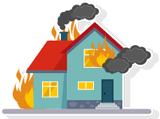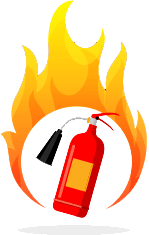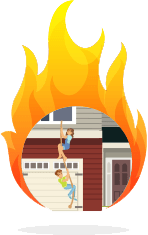Time is of the essence when it comes to fires at home. In two short minutes, a fire can become life-threatening. In five minutes, flames can engulf an entire home. Of course, prevention is just as important. From January 1, 2018, to January 1, 2023, a five-year period, the news media reported a total of 11,180 home fire deaths in the United States. Many, if not all, were avoidable.
It's essential for residents and families to become familiar with how fire spreads, the leading causes of home fires, and various fire safety methods. Awareness has resulted in fewer fire deaths in past years, but the number is still pretty high, especially considering that residential fires are preventable.
Staying safe from fires at home begins with you. Take action with the tips below.
Insight from the Experts
Curious to see what the professionals have to say about fire prevention at home? Here are some interesting bits of insight from fire officials:
Fire: Fast Facts
Before we get into the details of fire prevention at home, let's go over fundamental facts to understand fires better.
LUNG-SCORCHING
Flames are scary, but the heat a fire produces is more dangerous. Temperatures can reach 1,100 degrees Fahrenheit in less than four minutes. Even at just 600 degrees, a fire can melt your clothes and scorch your lungs. Temperatures are lower at floor level, sometimes only 100 degrees, so don’t be afraid to get on your hands and knees. Staying low also means you breathe less smoke.
DEADLY
You’re more likely to die from asphyxiation (smoke inhalation) than burns. In fact, a fire’s odorless, colorless toxic gasses can put you to sleep before flames reach your location. Watch out for smoke inhalation symptoms such as shortness of breath, cough, headache, disorientation, and drowsiness.
DISORIENTING
Many fires first appear yellow-orange but swiftly transform into black smoke that causes darkness. Fumbling around in pitch-black spaces costs valuable seconds.
QUICK
Small flames require less than 30 seconds to erupt into large fires. From there, a complete takeover of the house can occur in three to five minutes. New homes also burn faster and hotter than older residences due to different building materials and other factors.
Shocking Statistics about Home Fires

About 7 people die in the United States as a result of a fire at home.

On average, firefighters respond to a fire call in the United States every 24 seconds. Every 87 seconds, a home fire occurs. Source: Insurance Information Institute
There were 379,600 fires in residential buildings in 2018, leading to 2,790 deaths, 11,525 injuries, and losses of $8,194,500,000. That’s more than eight billion dollars, so all these zeros belong! Source: U.S. Fire Administration
About 25 percent of home fire deaths resulted from fires that started in the living room, while 23 percent started in the bedroom. Kitchen fires and cooking area fires accounted for the highest proportion of injuries, at 39 percent. Source: National Fire Protection Association
Fire Safety Tips
In any discussion about fire safety, we always start with the facts. They are indisputable, after all.
Here are a few, courtesy of the American Red Cross:
- Every day, 7 people die from a house fire. Children and the elderly are the most impacted.
- About 80% of all civilian deaths from fire occur in the home.
- The No. 1 cause of most house fires is unattended cooking.
As homeowners, we might not be able to prevent every single opportunity for a house fire. These things do happen, but fortunately, we have a great number of fire safety tips and tricks at our disposal to be as prepared as we possibly can.
According to a fire safety report, cooking, heating, and electrical equipment are three of the biggest factors in fire injury or death. So that’s always something to keep in mind: Knowing more about fire risks will help you protect your home.
Do you know if your smoke detectors are wired? Do they have a battery? If so, how long are they supposed to last? Have you labeled your smoke detectors or created a schedule to check in on them? These are all important questions when thinking about fire safety tips.
5 Tips for Preventing a Residential Fire
House fires are preventable. Every homeowner and family member should take the time to do the following to ensure fire safety.
 Install Smoke Detectors Throughout the Home
Install Smoke Detectors Throughout the Home
The first step is to install enough smoke detectors throughout your home. Aim for one on every floor, in each sleeping area, and outside of each sleeping area. Most home security systems automatically include smoke detectors. Test detectors once every month to ensure they work and that the batteries are still good. Replace batteries once a year, and completely replace detectors every 10 years. Do not disable any smoke detectors while cooking, as this can potentially result in tragedy. Fortunately, detector technology has improved, and “false” alarms due to cooking have decreased.
 Install Fire Extinguishers
Install Fire Extinguishers
Once you've got the smoke detectors installed, it's time to make sure that you have fire extinguishers readily available throughout your residence. These come in handy should you experience a small fire. Using a fire extinguisher prevents you and your family from having to battle a bigger fire. Keep them in the kitchen, garage, and any workshop areas of your home. Similar to smoke detectors, fire extinguishers should be checked regularly to ensure they work properly.
If you are not sure how to use a fire extinguisher, contact your local fire department for training information to get you started. You'll be able to learn how to properly use and maintain an extinguisher.
 Teach Kids About the Dangers of Fire
Teach Kids About the Dangers of Fire
Let's face it, kids are curious. This is a good and bad thing, but when it comes to something life-threatening like fire, curiosity can quickly turn into danger. Children under age six account for about 43 percent of home fires started by play, according to the National Fire Protection Association. These fires cause deaths, injuries, and property damage, just like other types of fire. It's essential to educate children about the potentially deadly consequences of playing with fire. Keep matches and lighters away from children, and inform them to stop, drop, and roll if their clothes catch on fire. Also, teach them about what firefighters do and not hide from them when they are in sight.
 Create a Plan for Escape
Create a Plan for Escape
Many people panic in emergencies, so an escape plan can mean the difference between life and death. The goal should be for everyone to get out of the house in three minutes or less.
Discuss the plan in detail with your family members so everyone is on the same page. The plan should include at least two escape routes from every bedroom. Everyone should be familiar with basic fire safety procedures, including these:
- Checking doors for heat before opening them
- Staying low on the ground to avoid smoke
- Knowing the closest way out
These little things go a long way to save lives during a fire. Make physical or digital copies of valuable documents such as health records so they’re quickly retrievable if a fire takes place.
Practice your fire escape plan. Fire drills are critical for people of all ages and let you test your plan for weaknesses.
Ensure that everything at home is in working order. For example, windows should not be stuck, and if you have any window screens, they should be easily removable. If you use security bars, make sure they are quick release.
 Have a Family Communications Plan Set
Have a Family Communications Plan Set
Ready.gov has a blueprint for developing a family/household communications plan for emergencies. The site also provides emergency plans for parents, kids, and pet owners.
- Collect data on potential meeting places in your neighborhood, relatives’ contact information, any medical issues responders need to know about, and places your family could stay for a while. The meeting place could be a neighbor’s house, a landmark, or even the end of your driveway if it’s far enough from the house. Think about accessibility needs. For instance, older family members may benefit from a medical alert system that enables easier contact with relatives and emergency responders.
- Share information such as meeting places and contact numbers with everyone in the household. Input contact numbers in all residents’ phones and devices. Include terms such as “911” or “Emergency” in the entry so all these numbers come up when you search the designated term. Create group lists to reach multiple people at once, and make sure everyone knows how to text, call, or otherwise reach out to their emergency contacts. Let your emergency contacts know about medical issues they should share with responders.
- Practice the plan. Each resident should get in touch with at least one emergency contact and send a group text. Verify that everyone in the household, children included, knows how to call 911. Look over the plan at least once a year, and update it as needed. Remind others in the household about it, too.
Common Causes of Fire at Home
Avoid starting a fire by getting to know common causes:
Clothing Dryers
Lint easily gets a fire started under the right conditions, so keep your clothes dryer well-maintained. Get the air exhaust pipe to the outside of the home inspected yearly to ensure no blockage. Blockages may interfere with the dryer working efficiently and safely.
After each load, clean the lint filter before starting a new load. Check around the drum as well, because sometimes lint collects in this area. If you can, avoid having your dryer operate overnight or while you are out of the house. Do several rounds of drying if needed, rather than overloading the dryer. Overloading may lead to an excess of lint, increasing the chances of a house fire.
Children & Pets
Many kids find fire exciting, so take steps to minimize the risks. Explain that fire is a tool and not a toy and go over escape and communications plans. Talk about smoke detectors and the sounds they make. Have your kids listen to the detectors and practice what to do if they hear that sound.
Keep children away from burning candles, lights, matches, and stoves left on. Similarly, you can't expect pets at home to behave around burning candles and other objects.
Electrical
Appliances
Faulty electrical appliances can result in a fire, so check your appliances regularly to make sure they are operating properly. Immediately unplug and replace cords that are frayed or damaged. Spread out your appliances so they don’t overwhelm outlets. Use only one extension cord per appliance. If you have kids at home, consider tamper-resistant outlets so that children don't injure themselves.
Don’t tuck extension cords under rugs, carpet, or furniture. Heat cannot escape from covered cords, and that’s a fire hazard.
Get in touch with an electrician if you experience blown fuses, flickering lights, sparking lights, or other recurring problems with outlets or wiring. Tackle these issues while they’re relatively small.
flammable Liquids
Liquids such as cleaning agents, paints, gasoline, and adhesives are highly flammable. Store them away from heat sources. If possible, keep them outside of the home in a ventilated and cool area.
Smoking
Smoking accidents are another common cause of house fires. It’s never a good idea to smoke indoors, so take a few extra steps to smoke on your balcony or in the backyard. After smoking, check that no embers smolder in the ashtray, or run it underwater.
Portable
Space Heaters
Space heaters come in handy during winter when you need to warm up only one room. Do use them responsibly. These heaters account for 43 percent of home heating fires and 85 percent of related deaths.
Keep flammable items at least 3 feet away from an operating space heater. Position the space heater on a flat and stable surface so that it doesn't fall on something and catch on fire. Some heaters automatically turn off when tipped over; they’re much safer. Don’t leave space heaters on overnight or leave them unattended.
Cooking
Cooking equipment is the number-one cause of home fires and injuries. Be especially careful when igniting grills and other cooking equipment since 66 percent of home cooking fires begin at the ignition stage. Never leave the kitchen unattended while cooking, and after you are done, ensure that the stove and/or oven is completely off. Keep hot items away from loose clothing, dish towels, and other fabrics that could cause a fire.
fireplaces
If you use a fireplace, get it checked out yearly. Operate it only when you’re home and ensure that fires are 100 percent extinguished before you go to sleep. Use a fireplace screen to protect against flying sparks. The screen should be big enough to cover the entire fireplace opening and heavy enough to withstand any logs that roll from the fire.
A Quick Note on Home Fire Sprinklers
The Home Fire Sprinkler Coalition offers a video with top-and-bottom comparisons of a home fire in a house with sprinklers and a home fire in a house without sprinklers. It gets the point across better than a long list of numbers might (also notice the disorienting, pitch-black effect of fire mentioned earlier). In a nutshell, fire sprinklers significantly increase your family’s odds of safe escape. They contain or put out fires, and minimize property damage.
Many homes don’t have them, but they’re worth considering if you have the means to install them. If you’re looking for a new place to live, you might prioritize residences that already have sprinkler systems. If you are building a home from scratch, new-construction sprinklers cost about $1.35 per square foot of space. It’s possible to retrofit sprinklers into your existing home, although it costs more.
Conclusion
You might think that these fire safety tips are common sense. However, it's easy to overlook them especially when you’re busy and stressed about work, the holidays, and more. The most basic precautions can slip through the cracks of daily life. So, whether you're reading this piece for knowledge or to get a much-needed reminder, know that you can never take it too safe with fire prevention at home. Taking the necessary measures saves a ton of hassle and your precious belongings and your loved ones!
Additional Resources
The following resources should expand your fire prevention and safety knowledge in multiple areas.
Fire sprinklers could save your life. This resource explains why, discusses the costs and types of fire sprinklers, and how they’re useful for senior citizens, people with disabilities, children, and pets.
Check out Sparky the fire dog, courtesy of the National Fire Protection Association. A dalmatian, Sparky debuted in 1951 and offers fun ways for kids to learn about fire. The website has free apps and a section for parents. It’s complete with resources such as a fire inspection checklist and how to make a fire escape plan.
National Fire Protection Association: Public Education
Learn about fire causes and risks, including regional and behavioral risks, and specific groups at risk. Take tangible steps to stay safe, including in high-rise buildings and nursing homes—no guesswork needed.
Research fire prevention, including the most recent studies on fire detection and suppression. Investigate U.S. fire statistics, state fire profiles, and other data.






 Install Smoke Detectors Throughout the Home
Install Smoke Detectors Throughout the Home Install Fire Extinguishers
Install Fire Extinguishers Teach Kids About the Dangers of Fire
Teach Kids About the Dangers of Fire Create a Plan for Escape
Create a Plan for Escape Have a Family Communications Plan Set
Have a Family Communications Plan Set






